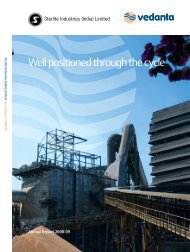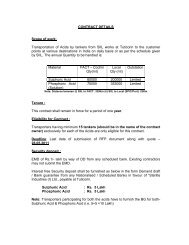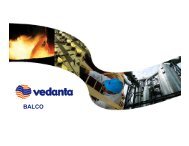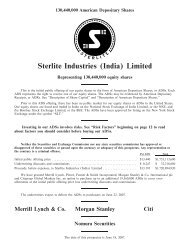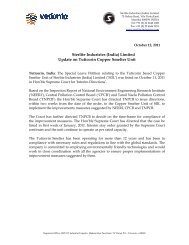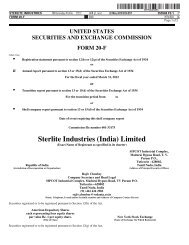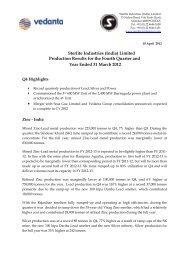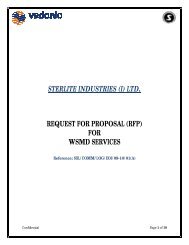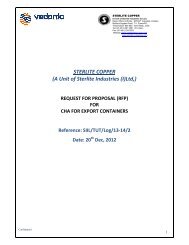Sterlite Industries (India) Limited - Sterlite Industries India Ltd.
Sterlite Industries (India) Limited - Sterlite Industries India Ltd.
Sterlite Industries (India) Limited - Sterlite Industries India Ltd.
Create successful ePaper yourself
Turn your PDF publications into a flip-book with our unique Google optimized e-Paper software.
We also review our property, plant and equipment, including mine properties, for possible impairment if there are events or changes in<br />
circumstances that indicate that the carrying value of an asset may not be recoverable and exceeds its fair value. In assessing property, plant<br />
and equipment for impairment, factors leading to significant reductions in profits such as changes in commodity prices, our business plans and<br />
significant downward revisions in the estimated mining reserves are taken into consideration. The carrying value of the assets and associated<br />
mining reserves is not recoverable if it exceeds the sum of the undiscounted cash flows expected to result from the use and eventual disposition<br />
of the assets. This involves management estimate of commodity prices, market demand and supply, economic and regulatory climates, longterm<br />
mine plans and other factors. Any subsequent changes to cash flow due to changes in the above mentioned factors could impact on the<br />
carrying value of the assets.<br />
Asset Retirement Obligations<br />
Liabilities have been recognized for costs associated with restoration and rehabilitation of mine sites as the obligation to incur such costs<br />
arises and when a reasonable estimate of such costs can be made. Such costs are typical of extractive industries and they are normally incurred<br />
at the end of the life of the mine. The costs are estimated on the basis of mine closure plans and the estimated discounted costs of dismantling<br />
and removing these facilities. The costs of restoration are capitalized when incurred, reflecting our obligations at that time, and a corresponding<br />
liability is created. The capitalized asset is charged to the income statement over the life of the asset through depreciation and the accretion of<br />
the discount on the liability over the life of the operation. Management estimates are based on local legislation and/or other agreements. The<br />
actual costs and cash outflows may differ from estimates because of changes in laws and regulations, changes in prices, analysis of site<br />
conditions and changes in restoration technology.<br />
Commitments, Contingencies and Guarantees<br />
We also have significant capital commitments in relation to various capital projects which are not recognized on the balance sheet. In the<br />
normal course of business, contingent liabilities may arise from litigation and other claims against us. Guarantees are also provided in the<br />
normal course of business. There are certain obligations which management has concluded, based on all available facts and circumstances, are<br />
not probable of payment or are very difficult to quantify reliably, and such obligations are treated as contingent liabilities and disclosed in the<br />
notes but are not reflected as liabilities in the consolidated financial statements. Although there can be no assurance regarding the final outcome<br />
of the legal proceedings in which we are involved, it is not expected that such contingencies will have a materially adverse effect on our<br />
financial position or profitability.<br />
Income Tax<br />
In preparing our consolidated financial statements, we recognize income taxes in each of the jurisdictions in which we operate. In each<br />
jurisdiction, we estimate the actual amount of taxes currently payable or receivable. We also estimate the tax bases of assets and liabilities<br />
based on estimates, and such estimates may change when the tax returns are prepared. Deferred income tax assets and liabilities are measured<br />
using enacted tax rates expected to apply to the year when the asset is realized or the liability is settled based on tax rates (and tax laws) that<br />
have been enacted as of the balance sheet date. We do not record deferred taxes on unremitted earnings of foreign subsidiaries, based on timing<br />
of the reversal of the temporary differences where it is probable that the temporary differences will not reverse in the foreseeable future or<br />
management intends to reinvest such unremitted earnings indefinitely. Deferred tax assets are reviewed for recoverability and a valuation<br />
allowance is recorded against deferred tax assets to the extent that it is more likely than not that the deferred tax asset will not be realized. If we<br />
determine that we will ultimately be able to realize all or a portion of the related benefits for which a valuation allowance has been provided, all<br />
or a portion of the related valuation allowance will be reduced with a credit to income tax expense.<br />
We evaluate each tax position to determine if it is more likely than not that a tax position is sustainable, based on its technical merits. If a tax<br />
position does not meet the “more-likely-than-not” standard, a liability is established. Additionally, for a position that is determined to be<br />
“more-likely-than-not” sustainable, we measure the benefit at the highest cumulative probability of being realized and establish a liability for<br />
the remaining portion. A material change in the tax liabilities could have an impact on our results.<br />
77



